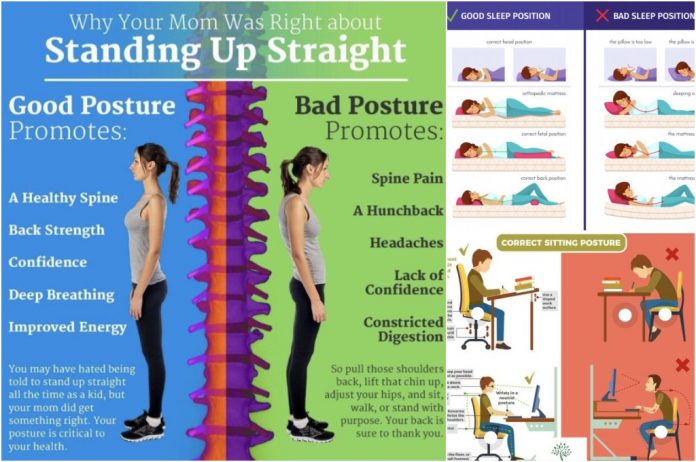We’ve all done it – nagged a friend, family member or a loved one to sit up straight, shoulders back, chin up and etc. Truth is; most of us have probably been on the receiving end of the exact same comments too. Countless hours spent hunched over desks, watching TV, on our computers or tablets, and carrying around heavy loads like backpacks and bags can take a toll on our bodies and, above all, our posture.
What is posture?
Posture is the position in which we hold our bodies while standing, sitting or lying down. Good posture is the correct alignment of body parts supported by the right amount of muscle tension against gravity. Without posture and the muscles that control it, we would simply fall to the ground.
Normally, we do not consciously maintain normal posture. Instead, certain muscles do it for us, and we don’t even have to think about it. Several muscle groups, including the hamstrings and large back muscles are critically important in maintaining good posture. While the ligaments help to hold the skeleton together, these postural muscles when functioning properly, prevent the forces of gravity from pushing us over forward. Postural muscles also maintain our posture and balance during movement.
Why is good posture important?
Good posture helps us stand, walk, sit, and lie in positions that place the least strain on supporting muscles and ligaments during movement and weight-bearing activities. Correct posture:
- Helps us keep bones and joints in correct alignment so that our muscles are used correctly, decreasing the abnormal wearing of joint surfaces that could result in degenerative arthritis and joint pain.
- Reduces the stress on the ligaments holding the spinal joints together, minimising the likelihood of injury.
- Allows muscles to work more efficiently and the body to use less energy preventing muscle fatigue.
- Helps prevent muscle strain, overuse disorders, and even back and muscular pain.
To maintain proper posture, you need to have adequate muscle flexibility and strength, normal joint motion in the spine and other body regions, as well as efficient postural muscles that are balanced on both sides of the spine. In addition, you must recognise your postural habits at home and in the workplace and work to correct them, if necessary.
Consequences of poor posture
Poor posture can lead to excessive strain on our postural muscles and may even cause them to relax, when held in certain positions for long periods of time. For example, you can typically see this in people who bend forward at the waist for a prolonged time in the workplace. Their postural muscles are more prone to injury and back pain.
Several factors contribute to poor posture – most commonly, stress, obesity, pregnancy, weak postural muscles, abnormally tight muscles and high-heeled shoes. In addition, decreased flexibility, a poor work environment, incorrect working posture and unhealthy sitting and standing habits can also contribute to poor body positioning.
Can I correct my posture?
In a word, yes. Remember, however, that long-standing postural problems will typically take longer to address than short-lived ones, as often the joints have adapted to your long-standing poor posture. Conscious awareness of your own posture and knowing what posture is correct will help you consciously correct yourself. With much practice, the correct posture for standing, sitting, and lying down will gradually replace your old posture. This, in turn, will help you move towards a better and healthier body position.
Here are some quick tips and tricks for maintaining ideal posture in sitting, standing, and while sleeping.

Sitting
| Do:
· Keep your head straight and face forward. If working at a computer, adjust your screen height accordingly · Keep your shoulders back. · Make sure your feet are flat on the floor. · Sit with your knees at the level of or slightly lower than your hips.
|
Avoid:
· Working without support under your arms or wrists. · Tucking your feet under your chair. · Rounding and slouching your back
|

Standing
| Do:
· Use your core muscles to stand straight. · Breathe deeply from your diaphragm (belly breathing). · Keep your shoulders back. · Keep a slight bend in your knees. · Use good shoes that offer support to your feet.
|
Avoid:
· Standing in one position for too long. · Wearing shoes with heels for prolonged periods of time. · Sticking your chest out. · Locking your knees back in extension. |

Sleeping
| Do:
· Find a position that’s comfortable for you. · Maintain a straight back using small pillows to fill any gaps. · If sleeping on your side, try putting a small pillow between your knees. |
Avoid:
· Sleeping with too many or too few pillows under your neck. Your neck should be straight and in line with your body while resting on your pillow. · If possible, avoid sleeping on your stomach. This position can cause strain on the neck and lower back. |




